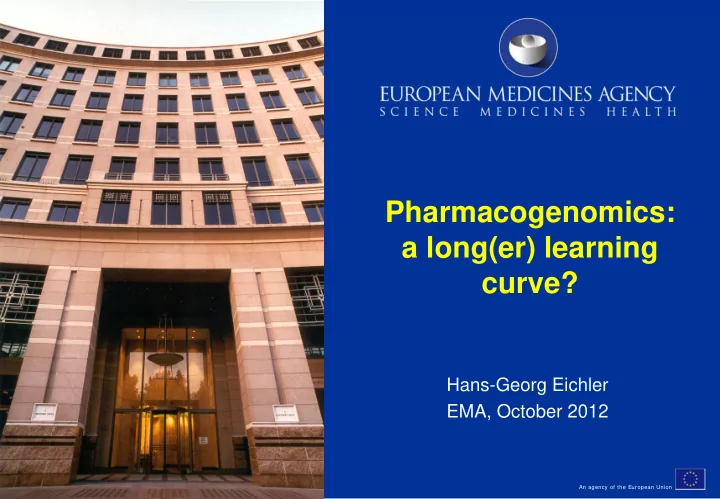

Pharmacogenomics: a long(er) learning curve? Hans-Georg Eichler EMA, October 2012 An agency of the European Union
Agenda • PGx - shades of grey • Learning curve/post-marketing evidence development • Regulatory versus HTA post-marketing information needs • The toolkit along the learning curve 2
Agenda • PGx - shades of grey • Learning curve/post-marketing evidence development • Regulatory versus HTA post-marketing information needs • The toolkit along the learning curve 3
Level of individualisation • Personalised medicine (e.g. autologous cellular therapy) • Multi-stratified medicine (e.g. CFTR-directed therapy, ca 1800 ‘strata’) • Binary stratification (e.g. HER2 +/-) 4
Level of individualisation • Personalised medicine (e.g. autologous cellular therapy) • Multi-stratified medicine (e.g. CFTR-directed therapy, ca 1800 ‘strata’) • Binary stratification (e.g. HER2 +/-) 5
Shades of grey Determinants of disease manifestation and treatment response: • Environment • Genetic background; modifier genes (genes that modify the clinical outcome of a genetic mutation) • ‘Stochastic events’ (? ; unknowns) Brunner HG. NEJM 2012; 367:1350-2; October 4, 2012 CDx don’t tell the whole story about response (e.g. Herceptin <50% response rate) 6
Shades of grey Biomarker: Single nucleotide polymorphism in the 3-hydroxy-3- methylglutaryl coenzyme A reductase ( HMGCR ) gene Drug: Statins; retrospective analysis identified two strata of patients, one reached total cholesterol target level in 71.9%, versus 49.0% in the other group. Clinical utility: •relatively benign safety profile of statins at appropriate doses, •benefit–risk positive for both populations? •Justification for restricting use to higher response stratum? Donnelly, L. A. et al. Pharmacogenet. Genomics 18 , 1021–1026 (2008) 7
Agenda • PGx - shades of grey • Learning curve/post-marketing evidence development • Regulatory versus HTA post-marketing information needs • The toolkit along the learning curve 8
The drug development / licensing paradigm Learn - confirm - license (Re-learn – re/de-license) 9
Evidence Development Strategies: Australian 2010 Draft for Consultation Document “Level 1: Double Randomized Trial” 10
The drug development / licensing paradigm Learn - confirm - license (Re-learn – re/de-license) CDx guided treatments: Retrospective; Retrofitting; Rescue 11
Goals of post-marketing requirements • Test-drug utilisation • Test performance in real-life • Impact of new test kits/methodologies • Clinical utility • Comparative/relative effectiveness assessment 12
Assessing test-drug utilization Example: Herceptin Background: physician adherence to guidelines Results: – HER2 testing occurred in 88% of all newly Is the test used? diagnosed patients, for whom testing is recommended. Is the pos/neg – Among those with HER2 testing performed, ratio similar to 21.5% were positive, 77.3% were negative, and clinical trials? 1.2% were unknown. – Of the 52 patients who used trastuzumab, only 1 Are the right did not have documented HER2 overexpression. patients – Of the 45 HER2 + , 13% did not receive treated? trastuzumab. 13 Barron JJ et al. The Oncologist 2009; 14:760-768
Test performance in real-life • Assay-performance characteristics may be lab-dependent • Positive and negative predictive value are population-dependent • Cut-off values are population-dependent 14
Impact of new test kits/methodologies • ‘Approved’ CDx will compete with alternative proprietary test or ‘home-brews’ for same biomarker • These may screen in or screen out different patients, impacting benefit-risk and cost- effectiveness (e.g. Herceptin and IHC/FISH/CISH) 15
Clinical utility Clinical utility: “is the test worth doing?” Woodcock J. Clin Pharmacol Ther 2010; 88: 765 Reflection paper on PG biomarkers. Australian Document: “Level 3: EMA/446337/2011 Randomized trial of drug only” 16
Clinical utility Clinical utility: “is the test worth doing?” Post-licensing research plan will depend on licensing pathway (e.g. determination of negative predicative value, case study: Ivacaftor*, effective in CF patients with G551D mutation, but not F508del mutation, other 1800 mutations?) * cystic finbrosis transmembrane conductance regulator (CFTR )potentiator 17
Relative Effectiveness Some specifics may vary, (e.g. pos/neg ratio in a given population may impact on cost- effectiveness)… but fundamental information needs about relative effectiveness are not much different for CDx guided and non-stratified therapies 18
Agenda • PGx - shades of grey • Learning curve/post-marketing evidence development • Regulatory versus HTA post-marketing information needs • The toolkit along the learning curve 19
Regulatory - HTA framework for post-marketing requirements? Regulators’ HTAs’ needs needs Treatment yes/no decision ++ ++ Stratification for maximum (+)/- ++ Efficacy (to optimise CE) Test-drug Utilisation ++ ++ Performance of drug in ++ ++ combination with new test (kit) Relative Effectiveness (+)/- ++ 20
Agenda • PGx - shades of grey • Learning curve/post-marketing evidence development • Regulatory versus HTA post-marketing information needs • The toolkit along the learning curve 21
A timely initiative “Methodologies for post authorisation safety and efficacy/effectiveness studies regarding PG and BM related issues (for adverse drug reactions and for lack of effectiveness) in the post marketing setting.” Concept paper on …PG methodologies in the pharmaco-vigilance evaluation of medicinal products; 15 Dec 2011; EMA/CHMP/917570/2011 “…stringent evidentiary requirements in the post marketing (post authorisation) era” Reflection paper on pharmacogenomic biomarkers … EMA/446337/2011 22
The drug development / licensing paradigm Learn – confirm - license Learn – license - confirm Lifecycle approach to research and licensing 23
24 Thank you! (EMA, Canary Wharf, London)
Research 101 • Temperature • Concentration of substrate • Concentration of inhibitor • … Experiment: all factors except one are kept constant 25
Recommend
More recommend